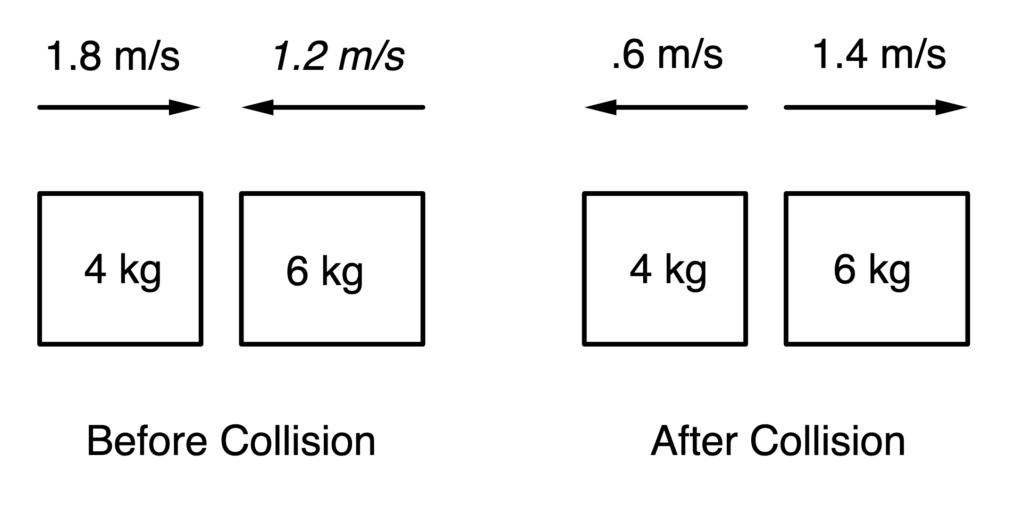| Step | Derivation/Formula | Reasoning |
|---|---|---|
| 1 | v = \sqrt{\frac{2 KE}{m}} | Initially, both blocks have the same kinetic energy, so their speeds are calculated using their respective masses. Since m_2 > m_1 , v_1 > v_2 (velocity of m_1 is greater than velocity of m_2 ). |
| 2 | W_{friction} = f \cdot d = \mu_k m g \cdot d | Friction does work to stop the blocks, where f is the frictional force and d is the distance before they stop. |
| 3 | KE = \frac{1}{2} m v^2 | The initial kinetic energy of each block. This is given as the same value for both blocks, depending on their mass and speeds derived above. |
| 4 | \mu_k m g \cdot d = \frac{1}{2} m v^2 | Equating the work done by friction to the kinetic energy of each block, solve for d . |
| 5 | d = \frac{\frac{1}{2} m v^2}{\mu_k m g} = \frac{v^2}{2 \mu_k g} | Since the mass m cancels out from the equation for d , the distance d each block travels before stopping depends only on v and not on m . Hence, m_1 which has a higher v will travel further. |
| 6 | (a) m_1 | Since v_1 > v_2 due to m_1 being less than m_2 but both having the same initial kinetic energy, block m_1 will travel further before stopping due to its greater velocity. |
The answer is: (a) m_1 will travel further before stopping. The determining factor here is that both experience the same deceleration due to friction (independent of mass), but the initial velocity of the lighter block is greater.
Phy can also check your working. Just snap a picture!
A rubber ball bounces off of a wall with an initial speed v and reverses its direction so its speed is v right after the bounce. As a result of this bounce, which of the following quantities of the ball are conserved?

From the figure above, determine the which characteristic fits this collision best.
A 100 kg person is riding a 10 kg bicycle up a 25° hill. The hill is long and the coefficient of static friction is 0.9. The person rides 10 m up the hill then takes a rest at the top. If she then starts from rest from the top of the hill and rolls down a distance of 7 m before squeezing hard on the brakes locking the wheels. How much work is done by friction to bring the bicycle to a full stop, knowing that the coefficient of kinetic friction is 0.65?
A pendulum bob of mass m on a cord of length L is pulled sideways until the cord makes an angle \theta with the vertical. The change in potential energy of the bob during the displacement is:
In which one of the following circumstances does the principle of conservation of mechanical energy apply, even though a nonconservative force acts on the moving object?
By continuing you (1) agree to our Terms of Sale and Terms of Use and (2) consent to sharing your IP and browser information used by this site’s security protocols as outlined in our Privacy Policy.
| Kinematics | Forces |
|---|---|
| \Delta x = v_i t + \frac{1}{2} at^2 | F = ma |
| v = v_i + at | F_g = \frac{G m_1m_2}{r^2} |
| a = \frac{\Delta v}{\Delta t} | f = \mu N |
| R = \frac{v_i^2 \sin(2\theta)}{g} |
| Circular Motion | Energy |
|---|---|
| F_c = \frac{mv^2}{r} | KE = \frac{1}{2} mv^2 |
| a_c = \frac{v^2}{r} | PE = mgh |
| KE_i + PE_i = KE_f + PE_f |
| Momentum | Torque and Rotations |
|---|---|
| p = m v | \tau = r \cdot F \cdot \sin(\theta) |
| J = \Delta p | I = \sum mr^2 |
| p_i = p_f | L = I \cdot \omega |
| Simple Harmonic Motion |
|---|
| F = -k x |
| T = 2\pi \sqrt{\frac{l}{g}} |
| T = 2\pi \sqrt{\frac{m}{k}} |
| Constant | Description |
|---|---|
| g | Acceleration due to gravity, typically 9.8 , \text{m/s}^2 on Earth’s surface |
| G | Universal Gravitational Constant, 6.674 \times 10^{-11} , \text{N} \cdot \text{m}^2/\text{kg}^2 |
| \mu_k and \mu_s | Coefficients of kinetic (\mu_k) and static (\mu_s) friction, dimensionless. Static friction (\mu_s) is usually greater than kinetic friction (\mu_k) as it resists the start of motion. |
| k | Spring constant, in \text{N/m} |
| M_E = 5.972 \times 10^{24} , \text{kg} | Mass of the Earth |
| M_M = 7.348 \times 10^{22} , \text{kg} | Mass of the Moon |
| M_M = 1.989 \times 10^{30} , \text{kg} | Mass of the Sun |
| Variable | SI Unit |
|---|---|
| s (Displacement) | \text{meters (m)} |
| v (Velocity) | \text{meters per second (m/s)} |
| a (Acceleration) | \text{meters per second squared (m/s}^2\text{)} |
| t (Time) | \text{seconds (s)} |
| m (Mass) | \text{kilograms (kg)} |
| Variable | Derived SI Unit |
|---|---|
| F (Force) | \text{newtons (N)} |
| E, PE, KE (Energy, Potential Energy, Kinetic Energy) | \text{joules (J)} |
| P (Power) | \text{watts (W)} |
| p (Momentum) | \text{kilogram meters per second (kgm/s)} |
| \omega (Angular Velocity) | \text{radians per second (rad/s)} |
| \tau (Torque) | \text{newton meters (Nm)} |
| I (Moment of Inertia) | \text{kilogram meter squared (kgm}^2\text{)} |
| f (Frequency) | \text{hertz (Hz)} |
General Metric Conversion Chart
Example of using unit analysis: Convert 5 kilometers to millimeters.
Start with the given measurement: \text{5 km}
Use the conversion factors for kilometers to meters and meters to millimeters: \text{5 km} \times \frac{10^3 \, \text{m}}{1 \, \text{km}} \times \frac{10^3 \, \text{mm}}{1 \, \text{m}}
Perform the multiplication: \text{5 km} \times \frac{10^3 \, \text{m}}{1 \, \text{km}} \times \frac{10^3 \, \text{mm}}{1 \, \text{m}} = 5 \times 10^3 \times 10^3 \, \text{mm}
Simplify to get the final answer: \boxed{5 \times 10^6 \, \text{mm}}
Prefix | Symbol | Power of Ten | Equivalent |
|---|---|---|---|
Pico- | p | 10^{-12} | 0.000000000001 |
Nano- | n | 10^{-9} | 0.000000001 |
Micro- | µ | 10^{-6} | 0.000001 |
Milli- | m | 10^{-3} | 0.001 |
Centi- | c | 10^{-2} | 0.01 |
Deci- | d | 10^{-1} | 0.1 |
(Base unit) | – | 10^{0} | 1 |
Deca- or Deka- | da | 10^{1} | 10 |
Hecto- | h | 10^{2} | 100 |
Kilo- | k | 10^{3} | 1,000 |
Mega- | M | 10^{6} | 1,000,000 |
Giga- | G | 10^{9} | 1,000,000,000 |
Tera- | T | 10^{12} | 1,000,000,000,000 |
The most advanced version of Phy. Currently 50% off, for early supporters.
per month
Billed Monthly. Cancel Anytime.
Trial –> Phy Pro
A quick explanation
UBQ credits are specifically used to grade your FRQs and GQs.
You can still view questions and see answers without credits.
Submitting an answer counts as 1 attempt.
Seeing answer or explanation counts as a failed attempt.
Lastly, check your average score, across every attempt, in the top left.
MCQs are 1 point each. GQs are 1 point. FRQs will state points for each part.
Phy can give partial credit for GQs & FRQs.
Phy sees everything.
It customizes responses, explanations, and feedback based on what you struggle with. Try your best on every question!
Understand you mistakes quicker.

For GQs and FRQs, Phy provides brief feedback as to how you can improve your answer.
Aim to increase your understadning and average score with every attempt!
10 Free Credits To Get You Started
*Phy Pro members get unlimited credits

By continuing you agree to nerd-notes.com Terms of Service, Privacy Policy, and our usage of user data.